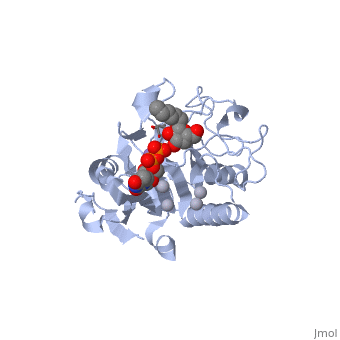1lzj
From Proteopedia
Glycosyltransferase B + UDP + H antigen acceptor
Structural highlights
FunctionBGAT_HUMAN This protein is the basis of the ABO blood group system. The histo-blood group ABO involves three carbohydrate antigens: A, B, and H. A, B, and AB individuals express a glycosyltransferase activity that converts the H antigen to the A antigen (by addition of UDP-GalNAc) or to the B antigen (by addition of UDP-Gal), whereas O individuals lack such activity. Evolutionary ConservationCheck, as determined by ConSurfDB. You may read the explanation of the method and the full data available from ConSurf. Publication Abstract from PubMedThe human ABO(H) blood group antigens are produced by specific glycosyltransferase enzymes. An N-acetylgalactosaminyltransferase (GTA) uses a UDP-GalNAc donor to convert the H-antigen acceptor to the A antigen, whereas a galactosyltransferase (GTB) uses a UDP-galactose donor to convert the H-antigen acceptor to the B antigen. GTA and GTB differ only in the identity of four critical amino acid residues. Crystal structures at 1.8-1.32 A resolution of the GTA and GTB enzymes both free and in complex with disaccharide H-antigen acceptor and UDP reveal the basis for donor and acceptor specificity and show that only two of the critical amino acid residues are positioned to contact donor or acceptor substrates. Given the need for stringent stereo- and regioselectivity in this biosynthesis, these structures further demonstrate that the ability of the two enzymes to distinguish between the A and B donors is largely determined by a single amino acid residue. The structural basis for specificity in human ABO(H) blood group biosynthesis.,Patenaude SI, Seto NO, Borisova SN, Szpacenko A, Marcus SL, Palcic MM, Evans SV Nat Struct Biol. 2002 Sep;9(9):685-90. PMID:12198488[1] From MEDLINE®/PubMed®, a database of the U.S. National Library of Medicine. See AlsoReferences
| ||||||||||||||||||||


